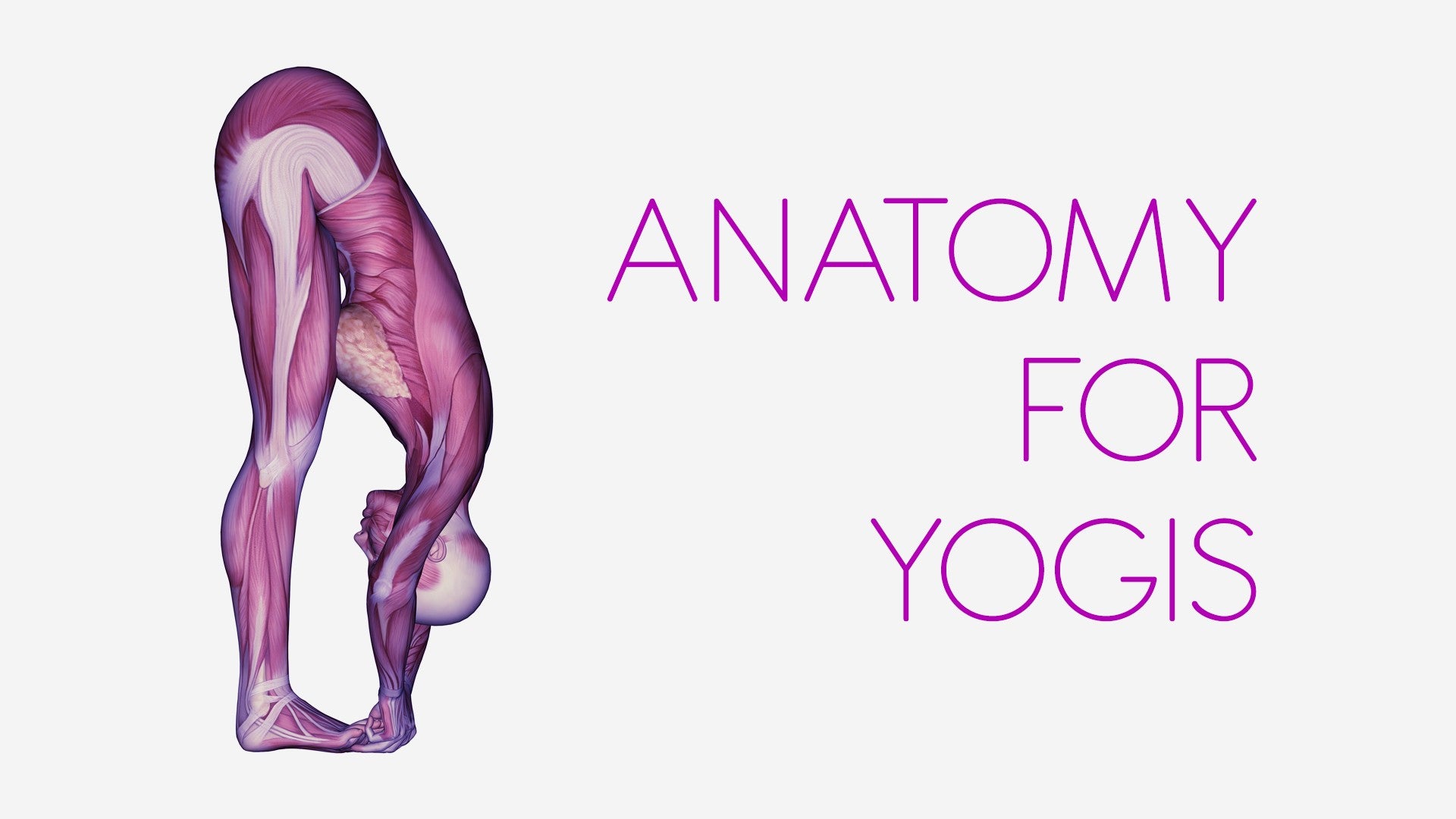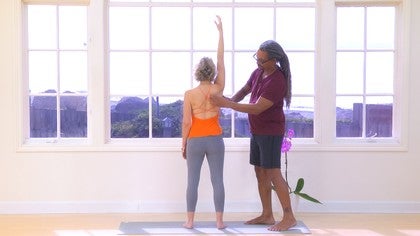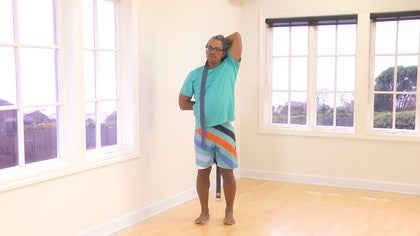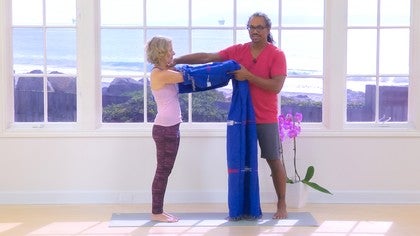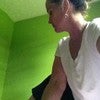Description
About This Video
Transcript
Read Full Transcript
Hi, welcome back. I'm Arturo and I brought my friend Tina with me today to be a model. We're gonna look at the shoulder joint, the shoulder complex, and the shoulder is a really amazing joint. Would you mind turning around, Tina? So the shoulder includes the scapula and the humerus and the collarbone, the clavicle, and it is the most mobile joint in the body. As Tina starts to move her shoulder blades around, you can see that the scapula, the shoulder blades, slides and glides along the ribs, and we also have the ability to move the humerus, the upper arm bone, bent elbow, this one, there we go, and then also the ability to do things with the arm, extending, reaching overhead, swimming, picking fruit, all kinds of things that really pertain to our survival, and that's really because of the great mobility of the shoulder. With the joints there's a balance. The more mobile a joint is, the less stable it's gonna be. The more stable a joint is, the less mobile it's gonna be, and with the shoulders great mobility, that means it's not a very stable joint. It's a joint that's easy to go out of whack. The shoulder joint type is a ball and socket joint. You have a socket in the shoulder blade where this ball of the upper arm bone fits into, but the socket moves around and the ball moves around in the socket. That's part of why we can reach overhead and get things off the top shelf. There aren't a lot of really strong ligaments stabilizing the shoulder. The main thing that's stabilizing the shoulder are muscles, and we have 17 muscles that attach to each scapula, providing stability, and the great thing about that is we have a lot of physical control, a lot of control with what we do with the shoulder, but the challenging thing with that is when the shoulder gets injured, the rhythm of the movement between the shoulder blade and the upper arm bone gets messed up. So let's look at that natural rhythm, the healthy rhythm of shoulder movement. First, I have to find her shoulder blade. So there's the inside border, this medial border, and here's the bottom corner of the shoulder blade. I'm just gonna hold that bottom corner of the shoulder blade, and this triangle basically gives us the shape of the shoulder. So as Tina starts to slowly take her arm out to the side, we can see that the shoulder blade stays pretty still until she gets to about 90 degrees. Then the shoulder blade, as she goes up higher, the shoulder blade starts to rotate, rotate, so the bottom corner of the shoulder blade really moves in towards the armpit, and then back on down. Great, so that's pretty normal movement of the shoulder blade. Her shoulder is really healthy. When there's been an injury like a rotator cuff tear or a broken collarbone, for example, one of the things that you'll start to see is we lose that separation, we lose that rhythm between the humerus, the upper arm bone, and the shoulder blade. So what you might see as she brings her arm out is that the shoulder starts to shrug up to the ear because she can't separate these two. She doesn't get that full 90 degrees of freedom, and you see a lot of people tip to the side like this when they start to reach their arm up overhead. Oftentimes, completely unconsciously, that compensation, you say reach your arm up overhead and they just tip to the side and go like this? Yeah, that's good. So what can we do about that? So let's look a little bit of the main muscles around the shoulder girdle. One of them is up on the cape, this cape muscle on the top of the shoulder, the trapezius, and what it does is it helps rotate the shoulder blade up when the arm gets above 90 degrees and coming out to the side. As she lifts it up a little higher, you'll see the shoulder, the trapezius, start to engage here. Come on back down. Also, we have these muscles that are kind of going like Christmas tree shape to each side, and those are the rhomboids, and they help, they have to relax to allow the shoulder blade to move up, and a lot of times they get locked down, especially when there's a shoulder injury. A lot of the muscles splint the shoulder blades to help immobilize the shoulder, and then on the shoulder blade itself we have four muscles, the rotator cuff. We have one down here, the infraspinatus, one on the top of the shoulder blade, the supraspinatus, one kind of near the armpit edge of the shoulder blade, the teres minor, and then on the front side of the shoulder blade, up against the ribs is the infraspinatus. They all help to hold the shoulder blade in the socket, and that's a really common, the rotator cuff really commonly gets torn, and that messes up the rhythm of the shoulder movement. So let's feel the shoulder blade. I want you to do what I just did a minute ago, find the bottom corner of the shoulder blade, get a friend, find the bottom corner of the shoulder blade, and when you're looking for something in this area or anywhere on the body, whenever you're searching to find something, it's helpful to use circles over the skin. If I'm poking and looking, that's going to be really irritating.
Circles, I can disguise my searching like massage, and she doesn't care that I'm searching for this bony corner, and then I can find the top ridge of the shoulder blade like this, and now I can follow the movement of her shoulder blade as she takes her arm straight out to the side, and up overhead. There it goes, and back down. Great. We're going to learn a couple of fun partner massage releases, so this is great to do with a friend and great to teach the friend how to do it to you. You can also do these releases with a ball, placing a ball in the two areas that we're going to work on, and in one of the other videos on this site, you'll see that we have a routine doing some of the ball work in these areas in the rhomboid areas. So I can also do that with my hands, since I'm doing it with a friend, to do these circles just on the inside of the border of the shoulder blade, and do the circles to find these lumps and bumps. Tender point there. Okay, and then I'm just going to hold that with a little pressure. Normally I would get right here and use my body weight, but I'm going to stay out of the way so you can see a little better, and then I'm going to have her do that same movement out to the side, and slowly up. Is that too much pressure? And slowly up, and lengthen. There we go, and back down. This is a technique called pin and stretch. I'm going to find another point in the same neighborhood, and go ahead slowly. I can feel the muscle contracting to stabilize the shoulder blade, and now I feel it stretching underneath the pressure of my finger, and back down. Third time's the charm. Let's find a third special point. There's all sorts of lumpy bumps in here. This area will get really locked up with, the most common thing is with sitting at a computer in the hunchpose, or smartphones. Makes this area get locked up. Okay, and one more time. Is that a good point? And slowly up, and lengthen. There we go, and slowly back down. For the next point, we're going to find that triangle of the shoulder blade, and come right into the center of the triangle. This is on the infraspinatus muscle, and I'm going to do the circles again, and with the circles looking for, you can even see how I'm clunking over a speed bump there. So I'm going to come right to the edge of that bump, apply some pressure, and the amount of pressure I want to use is just enough to where it hurts good. It has a good achy feeling. Not so much that she's gritting her teeth or squinching her eyebrows together, but just that all good achy feeling right there. Is that enough? Is that good pressure? Now for this, I'm going to have her do a different movement. Instead of out to the side, I'm going to have her reach her arm forward, palm up, and then slowly turn the thumb down, and the elbow towards the ceiling. First I want to find my point, hold a little pressure. Is that a good amount of pressure? And then with your palm up, reaching your hands toward your right hand towards the ocean, good, and then slowly rotate the palm down, then the thumb down, and let the elbow come up towards the sky, and slowly come back down. And when she relaxes completely, I'm going to find a new point. So just to be clear on what the motion she's doing is, she's going to reach the hand forward, palm up to about shoulder height, and then slowly turn the palm down, and let the elbow rotate up. So the thumb ends up pointing down, and the upper arm internally rotates. That's what's going to stretch this infraspinatus muscle. Let me find another point. Ooh, that feels like one. Okay, is that a good amount of pressure? So slowly again, reaching the palm up, fingertips towards the ocean, and then, yeah, that's right, palm down, thumb down, elbow up, up, up, up, up, up, up, and slowly release. Ooh, let's do a third point. You can do three, you can do five points. That's a really good one right there. Can see how I'm kathunking over a knot there. I'm going to press right into that. Good pressure. That works. Okay, slowly, palm up, fingers towards the ocean, and slowly rotate the thumb towards the earth, the elbow towards the sky, elbow up, up, up, up, up, up, up, up, up, up, up, up, up, up, and slowly release. Okay, you can also do this on yourself with a ball, like a tennis ball, or you might need something harder like a lacrosse ball that you can bring right into these points when you're lying on your back and do some movement. You pin the point with the pressure and then stretch it with movement. That's the whole idea behind pin and stretch, and that helps to free up the layers of adhesions, the stuck layers, and the connective tissue, the knots that are often generated with injuries from scar tissue. Really good technique for breaking things up. And I can circle around, and there's just, there's a plethora of points on most people's shoulder blades. So you can see here how there's, where the areas I'm working, you see this little bit of redness come up. That's a good sign. That's a sign that there's circulation coming into the area. It's a little bit, it looks a little irritated, but actually that's a kind of a good irritation. The circulation is being improved, and increasing circulation through tight muscles is one of the best things that you can do for a tight muscle. Oftentimes when the muscle musculature gets tied and locked down, that restricts the blood flow, and that can perpetuate an injury. Blood brings oxygen and helps clear away waste products, so these little red spots are really good. I don't want to go so hard that I'm gonna bruise her, but this little bit of redness will fade pretty quick over the next few hours. How often would you do something like this, and why would you do, this is something really good to do if somebody's having limitation in the movement of their shoulder. I do a lot of the techniques with the ball on these points in my classes with seniors, because many of my seniors start to develop difficulty in doing things like putting a shirt on, reaching their hand up overhead, and they really appreciate being able to do this self-massage to help free up and gain more mobility in their shoulders. The greater mobility in the shoulders means a greater quality of life. They can do more things for themselves, and that's very helpful. You wouldn't do this every day. This is something you could do maybe three times a week, because it is, as you can see by this redness, it's getting the body to have a response, and you want to let the person, the body, recover in between times. So doing it, a lot of times people, when they learn a good self-massage treatment thing, they're going to do it every day, all day, and you can overdo it, especially when you're coming back from an injury. It's better to treat a little bit too little and let the body take the benefits of the treatment and kind of run and continue the benefits than to over-treat, and then after over-treating their soreness, bruising, they have to recover from the treatment, and that's not ideal. We want folks to feel better after getting these released. Let's see what your shoulder blades doing now, just for fun. Slowly take your arm out to the side. I'm just going to track the movement of her shoulder blade again and see, there goes her shoulder blade starting to move forward, and slowly back down. There's no clicking this time. The earlier times we had some clicking. If somebody has an injury on one shoulder, you could spend some time doing this or teaching them to do this themselves on the one shoulder, but always do something on the other shoulder. We don't want this other shoulder to get jealous. People use both of their shoulders, even their non-dominant hand, pretty evenly, and when you injure one, the other side tends to pick up the slack, so we want to keep the other side happy as well. Thanks so much for watching today, and I hope you enjoy exploring the movement of your shoulders.
Anatomy for Yogis: Arturo Peal
Comments
You need to be a subscriber to post a comment.
Please Log In or Create an Account to start your free trial.
